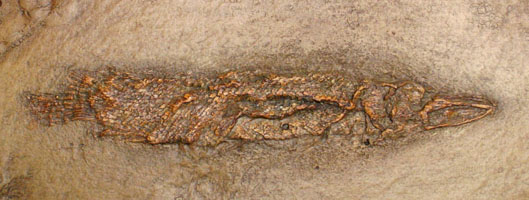The Messel Pit is a no longer used quarry near the village of Messel which is located about 35 km south east of Frankfurt, Germany. The quarry was used to mine bituminous shale. On December 9, 1995, the Messel Pit was declared a World Heritage site by UNESCO. The Messel Pit has been known for its fossils since about 1900, but was not seriously excavated for scientific study until the 1970's. The Messel Pit was closed to collecting in 1974. Therefore only specimens collected before that date are available to the market today.
Fifty million years ago, during the Geiseltalion Period, the Messel area was covered by a large series of lakes which were surrounded by lush sub-tropical forest that supported and incredibly diverse variety of life forms. The oil shale, present today, was created by the slow decomposition of dead vegetation in an anoxic environment combined with the fine grained sediments which accumulated at the bottom of these lakes. Because the plants and animals were deposited at the bottom of these lakes where there was little or no oxygen present, very little disturbance or scavenging would have taken place. This, along with the fine grained sediments, led to the excellent preservation of complete skeletons, including skin, fur, and feathers in some cases.
It is believed that the Messel Pit area was geologically active during the Eocene. Subsurface shifts may have periodically released concentrations of gases (carbon dioxide and hydrogen sulfide) into the lake and surrounding areas, overwhelming and killing any animals which were near.
You will find that nearly all specimens from Messel, Germany will be encased in epoxy, resin, or Lucite. This is due to the fact that the shale layers that the fossils are found in are made up of about 40% water and 8% oil. When the water evaporates, the shale and the fossils become very unstable and they turn to powder. They are stabilized with epoxy, to prevent this decomposition, and later as time permits, they are encased in resin or Lucite.
Atractosteus strausi was an alligator gar. Atractosteus comes from the Greek word atractos (meaning arrow). Gars are members of Lepisosteiformes and are found from the Permian Period to the present day. Their primitive traits are a heterocercal tail (meaning the upper lobe of the tail fin is larger than the lower with the end of the vertebral column prolonged and somewhat upturned in the upper lobe), a swimming bladder which is open to the pharynx that can function as a lung, and very hard armour-like ganoid scales. Because of their vascularized swim bladders most gars surface periodically to gulp air allowing them to live in stagnate waters which would kill most other fish. Gars are slow moving except when they strike at prey. They typically feed on smaller fish and invertebrates, such as crustaceans.
Atractosteus strausi 
Quantity in Basket: None
Code: OST-010
Price: $114.00
Shipping Weight: 1.00 pounds
Time: Middle Eocene Epoch approximately 49 million years ago
Location: Messel Formation, Germany
Dimensions: 11-1/2" x 5-1/4" x 1"